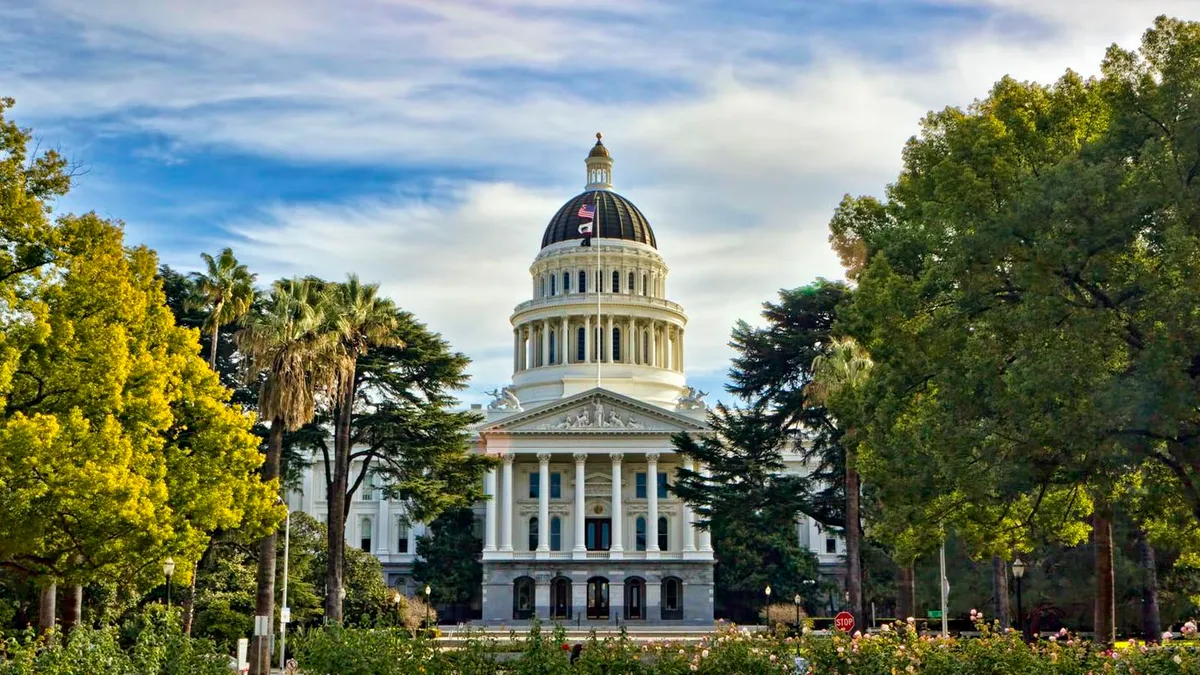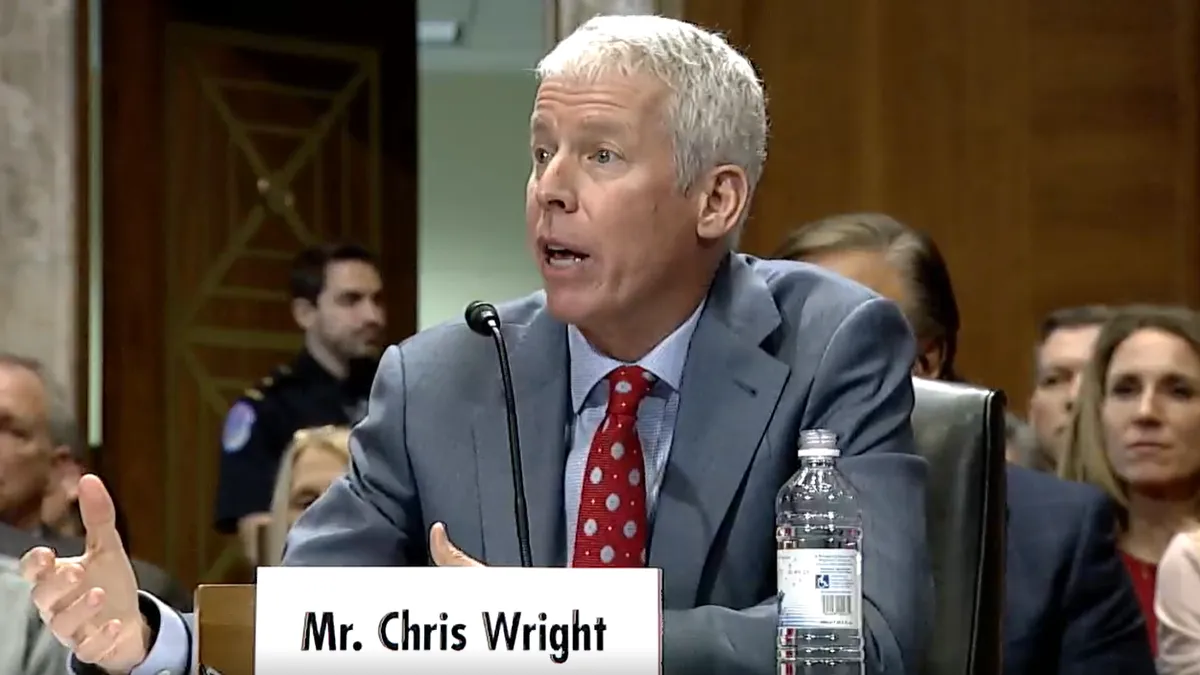California made history with the 100% clean energy target signed by Gov. Jerry Brown, D, on Monday, but decisions avoided by state lawmakers in the recently concluded legislative session are sowing doubts about whether the state can meet its ambitious aims.
While California is the nation's leader in solar deployment and in the top five wind energy states, renewable resources remain about 30% of its power mix. Bills to jumpstart renewables procurement expand the state's wholesale power market aimed to speed the state on its path to 100%, but both failed to pass in the legislative session that concluded last week.
Without them, critics say the lofty goal may never become a reality.
Failure to pass the two bills was "not good," Jan Smutny-Jones, former chairman of the board at the California Independent System Operator (CAISO), told Utility Dive. "We cannot meet our renewables and climate change goals by just shutting down natural gas plants."
Smutny-Jones is now the CEO of the Independent Energy Producers Association, a trade group that represents both natural gas and utility-scale renewables generators.
IEPA supported Senate Bill 100, which set the 100% clean energy goal, as well as Assembly Bill 893, which would have mandated new renewables by the mid-2020s, and Assembly Bill 813, which would have merged California’s wholesale market with others across the West to expand renewables access.
Those positions differed from many taken by California's investor-owned utilities (IOUs), which were largely focused on their liability for the wildfires that have ravaged the state for two years. They opposed legislators' 100% clean energy goal as putting "the cart before the horse" and rejected the procurement bill as an imposition on their planning processes. For the most part, they steered clear of addressing the grid expansion bill.
But now, with the 100% goal in place, a number of stakeholders agree with Smutny-Jones's concern that AB 813 and AB 893 may be necessary if the state wants to make it to 100% without breaking the bank.
Going big on renewables
For electric utilities and generators, two bills passed that could eventually boost renewables.
SB 100 — the 100% goal
SB 100 increased California's 50% renewables mandate to 60% by 2030 renewables and set the 100%-by-2045 target. It passed thanks to wide support from renewables and environmental advocates and from California’s budding customer choice movement.
IEPA supported the bill because its gas generator members expect most of their plants "to be fully depreciated and reaching the end of their useful lives by 2045," Smutny-Jones said.
The State Building and Construction Trades Council, a major labor union, also supported SB 100, according to Attorney Marc D. Joseph, who represented it and the Coalition of California Utility Employees during the session.
The state's dominant IOUs — PG&E, Southern California Edison (SCE), and San Diego Gas and Electric (SDG&E) — opposed SB 100 due to reliability concerns and the potential for higher customer bills.
In rejecting the bill, all three utilities warned against moving too quickly to higher renewables penetrations.
The bill does not "protect customers from high costs" or "define an 'unreasonable' rate and bill impact," SCE's statement said. And it does not empower regulators to determine "if customer costs become unaffordable."
The legislature should first "address the urgent policy needs around the impacts of more frequent and intense wildfires," PG&E added.
Finally, the bill does not clarify how procurement should be allocated as load shifts from IOUs to customer choice aggregators (CCAs), SDG&E and SCE said.
The CCAs supported the 100% goal, Executive Director Beth Vaughan of the California Customer Choice Association (CalCCA) emailed Utility Dive.
The CCAs had two key concerns, according to Vaughan. Like the IOUs, they did not want their procurement independence "undermined." And they wanted costs fairly allocated between themselves and other load serving entities (LSEs), including the IOUs. The final bill language met those concerns, Vaughan said.
Increases in California renewables mandates have always faced the objections raised to SB 100, lead sponsor Senator Kevin De Leon said in a press conference following the bill's passage.
"Opponents of change have always said higher levels of clean energy would be too expensive or a threat to reliability, and have always been wrong," he said. "They will be wrong again."
SB 901 — utility wildfire protections
Senate Bill 901, stakeholders agreed, was also key to renewables because California's IOUs must be financially solvent to sustain the renewables procurement. The bill was the product of a special committee called for by Brown to address wildfire prevention and IOU instability.
There was little controversy over new funding provided by the bill for wildfire prevention and response.
The critical element, eventually stripped from the bill, was a legislative fix for the heavy liability risk for utilities imposed by the state's controversial strict interpretation of the principle of inverse condemnation. At present, if utility infrastructure is a "substantial cause of fire," courts must impose all damage costs on the utility, even if regulators find its prevention efforts were "reasonable and prudent."
Brown proposed that lawmakers instruct courts to consider the "public benefit" of utilities and require them to compensate only for their "proportionate fault" in wildfires. By reducing utilities' burdens, this would get wildfire victims more promptly compensated. It would also protect utilities from a potential loss that could make them insolvent and therefore make the state's renewables and climate goals harder to achieve.
But lawmakers found a legislative change to a decision made by the courts unwise. They instead included provisions in SB 901 allowing California regulators to grant utilities limited recovery of liability losses. More importantly, they approved securing long-term, low-risk bonds with utility-owned assets. Sales of securitized low interest bonds will provide cash with which IOUs can address wildfire liabilities.
SCE endorsed early versions of the bill that included a legislative revision of the liability law. Its enthusiasm was muted for the final version without it. PG&E unenthusiastically accepted the final version as "a common-sense approach."
A more accurate assessment of the impact of SB 901 may have been Moody's Sept. 6 downgrading of all three IOUs' credit ratings. PG&E went from the A category to the low B category. SCE and SDG&E went from higher A to lower A ratings.
Customer advocates did not like the final bill either.
It put "shareholder profits over safety" and shifted the considerable burden of wildfire costs for PG&E's "neglect" to ratepayers, Democratic Sen. Jerry Hill, whose district is served by PG&E, told Utility Dive. Instead of making shareholders finance liability incurred due to utility negligence, "this bill allows PG&E to pass costs on to ratepayers."
Ratepayer advocacy group The Utility Reform Network was more adamant.
"PG&E has convinced the legislature to give it not only an unprecedented bailout on future wildfire liabilities, but also unlimited rate hikes for decades to come," it said in a statement. "The results for customers could be catastrophic." The group is calling for a veto from Brown.
Representatives of wildfire victims were satisfied that the inverse condemnation principle imposing legal liability on utilities for wildfire damages remained in place.
If utilities were relieved of their liability, victims in California's under-resourced counties would be unable to obtain prompt and just compensation and may not be able to remain a part of county tax bases, California State Association of Counties (CSAC) Policy Director Darby Kernan recently told Utility Dive. The current liability rules conclusively impose the burden for compensating victims on the utilities and "the counties want it to stay that way."
With inverse condemnation "off the table," Kernan said, the securitization in this version of SB 901 will protect the counties and those of their constituents who were fire victims, but also "keep utilities stable."
The final bill will eventually "serve its purpose of calming the financial markets and creating a path forward," Center for Energy Efficiency and Renewable Technologies (CEERT) Executive Director V. John White told Utility Dive. Many stakeholders are unhappy but "finding another way to fund liability was too difficult."
Keeping CAISO at home
Opposition in the California legislature kept two other bills stuck in committee -- at least until next year.
AB 813 — CAISO expansion
AB 813 would have changed the California Independent System Operator (CAISO) governance to allow a regional grid system and power market.
Not passing AB 813 and beginning the process of regionalizing California’s grid “was a missed opportunity,” said Lauren Navarro, senior California policy member at the Environmental Defense Fund (EDF), in a statement.
Its failure did not surprise those who understood how politically challenging it was, CEERT’s White said.
“Parochial interests representing labor unions that are politically powerful” kept AB 813 off the Assembly floor,” Smutny-Jones said. “Whatever their short-term interests, they are preventing what is necessary to meet long-term goals.”
“AB 813 would have severely damaged our clean energy goals,” labor groups attorney Joseph said. “We plan to propose a better plan, one that does not gut our renewable program and destroy California jobs.”
The IOUs stayed out of the debate.
Navarro, White, and Smutny-Jones agreed a regional grid will likely be necessary to achieve the SB 100 goal. They recognized, however, that sharing governance of California's grid with other states seemed threatening to lawmakers.
"Trump hysteria definitely helped block the bill," Smutny-Jones said. "The worry about federal intervention was overstated but easy to argue."
"Regional operation of the Western grid will provide savings to ratepayers and is also critical if we are to achieve deep reductions in greenhouse gas emissions from the electricity sector," Assemblymember Chris Holden, lead sponsor of AB 813, emailed Utility Dive. While it didn't pass this year, work on this bill will be "valuable to future efforts."
The CAISO and other SB 813 supporters will now work to expand the West's voluntary real-time Energy Imbalance Market (EIM) to a Day-Ahead EIM, White said. "That will allow more potential supporters of regionalization to get comfortable with the concept."
Smutny-Jones disagreed. "The Day-Ahead EIM is complicated and will not serve the same purpose," he said. "But the effort on regionalization will come back."
SB 893 — jumpstarting renewables
SB 893 was a last-minute effort to mandate near-term procurement by California LSEs of 5,000 MW of "qualified" renewables, including utility-scale wind, solar, geothermal, and biomass.
Streamlining renewables procurement has become necessary due to uncertainty about how future customer load will be divided between IOUs and other LSEs.
Due to the rise of CCAs, retail electricity providers, and customer-sited generation, IOUs’ 70% share of California's 2017 load will fall to 57% in 2020 and could fall to 15% by the mid-2020s, according to a recent forecast.
As new entities, CCAs are procuring as fast as possible, but are having little impact. IOUs don’t want to invest in resources on behalf of departing customers.
"The dearth of procurement is a direct result of CCAs failing to make long term investments in clean energy," Joseph said.
Under other circumstances, the state might wait for the California Public Utilities Commission (CPUC) Integrated Resource Planning (IRP) proceeding to resolve the question of CCA and IOU responsibilities. But wind and solar projects must commence construction by the end of 2020 to qualify for valuable federal tax credits. Delaying procurements will increase costs for customers, both White and Smutny-Jones said.
Support for the bill was the top priority of the national solar and wind advocacy groups because SB 100 "doesn't get solar and wind built fast enough," they said in a joint statement. "And about $1 billion in federal tax credits go away in 2020."
IEPA would not normally support the type of procurement mandated by AB 893, but "we are stuck in a world with no procurement," Smutny-Jones said. It could "take years" to fully resolve the questions of customer load, he added.
The IOUs and CalCCA, normally rivals, joined in opposition to AB 893's dictating of what resources they should buy and when.
It would have increased customers' bills "by billions of dollars" and compromised "system reliability," their joint statement reported. It also would have undermined the CPUC's IRP process, they agreed.
Bill sponsors "may come back next year with an urgency bill which, with a two-thirds vote, could go into effect immediately," White said. "But that may not leave enough time for developers to secure the tax credits."




















